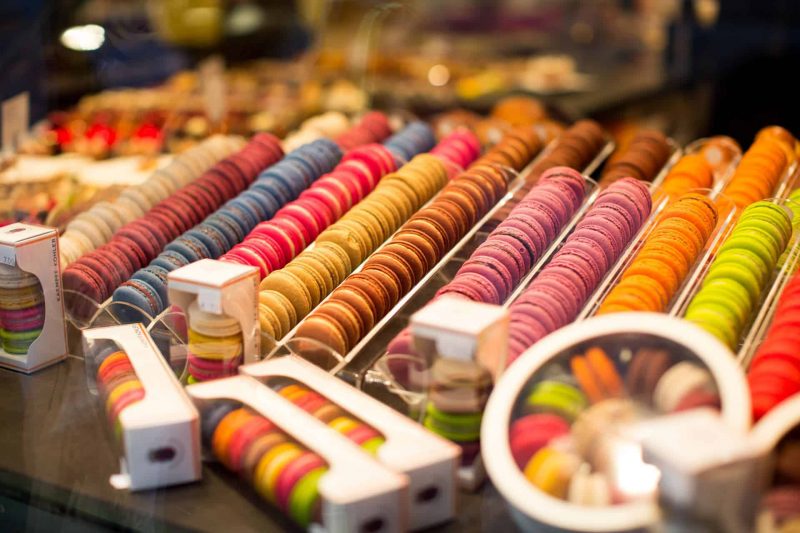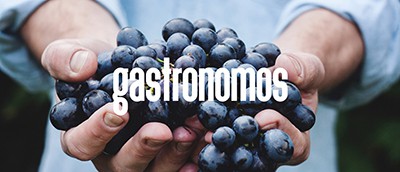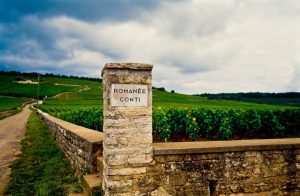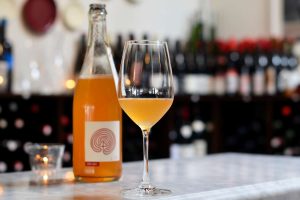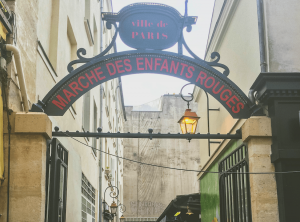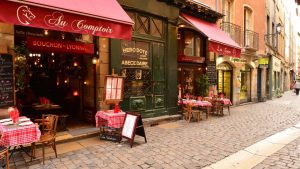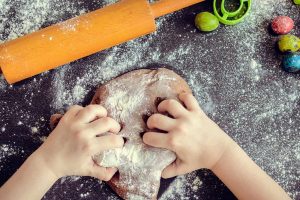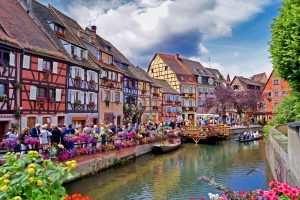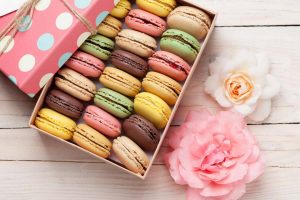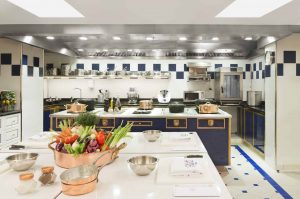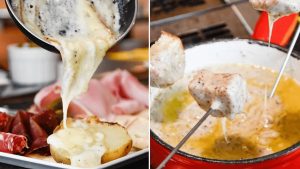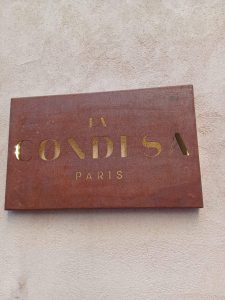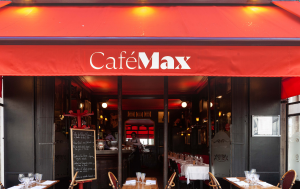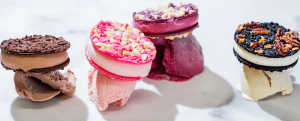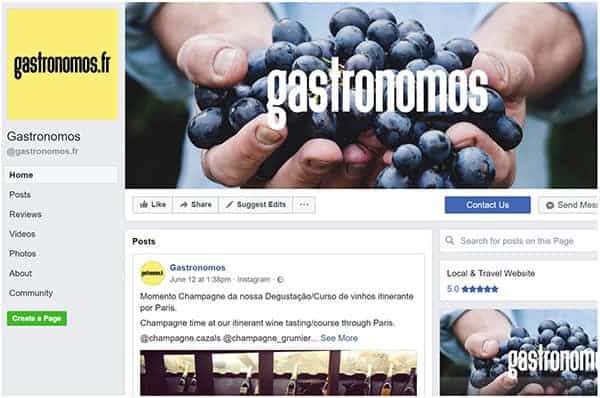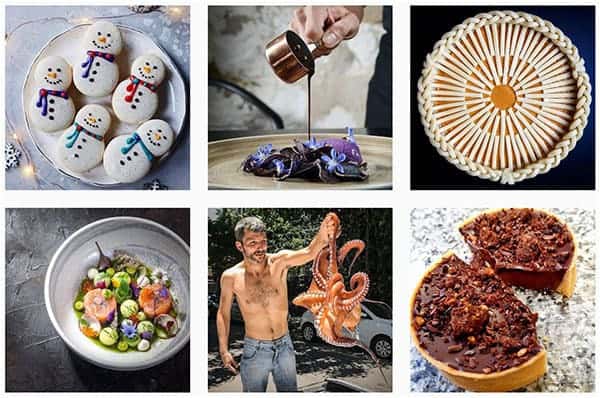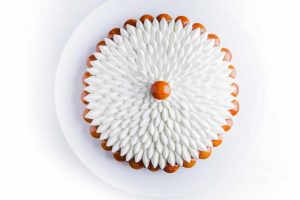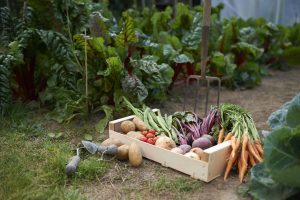It is small, round, delicious and has won the most demanding palates worldwide: Macaron, the current king of French sweets.
It is no wonder that the our macaron course here in Paris is one of the most requested experiences at Gastronomos. This patisserie is one of the sweets most loved by the French themselves and visitors in general. Taking part of this macaron class in Paris is a delightful experience for all travelers and families who seek an interactive and fun activity.
But what, after all, is macaron? How did it come about? What is the origin of macaron? What is macaron’s recipe? What are the best tips and tricks for making the best macaron in the world? Where to buy the best macarons in Paris?
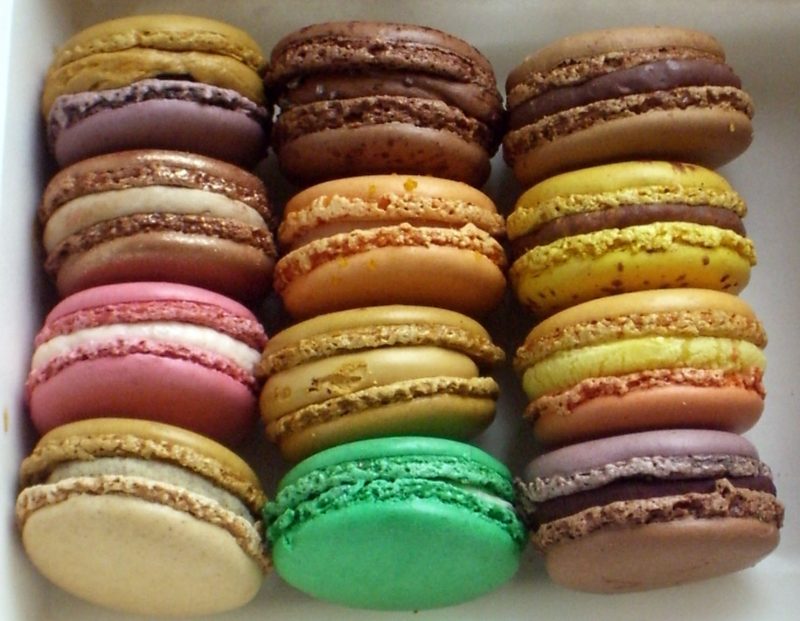
What is macaron?
The macaron is a small biscuit made with almond flour, granular and soft, rounded with an average of 3 to 5 cm in diameter. It is a specialty in several cities and regions of France and so the recipe and presentation can change from one place to another. Some examples are the macarons of Amiens, Boulay, Chartres, Cormery, Joyeuse, Le Dorat, Massiac, Montmorillon, Nancy, Rau, Saint-Emilion, Sainte-Croix Lannion or Sault. Are the cities in which the macaron is undoubtedly a gastronomic heritage.

All the macarons of the cities mentioned above have in common the fact that the base dough is a derivative of meringue, almond flour, icing sugar, white sugar and egg white. Usually the recipe calls for the same amount of icing sugar and almond flour. Other measures may vary from recipe to recipe, some macaron recipes may include fillings, some not. Another tradition that does not change is that in addition to being round all the macarons are roasted, however the temperature and the time in the oven also vary from recipe to recipe.
History of Macaron
Its popularity is undoubtedly linked to the variety of its recipes that make today’s macaron the result of a long evolution of the macarons of the past. The name macaron would be of Arab origin; it is even known and consumed in Syria under the name of louzieh (meaning almond) because it is closely associated with the production of this walnut. The earliest known recipes date back to the Renaissance.
The boom in maritime trade allowed imports of almonds into Italy.
The word comes from macaroni or maccherone in Italian. But in this case it is the almond paste that became the main ingredient of the Italian confectionery when it (the almond) was introduced in Italy in 1500. A simple and popular biscuit appeared among the Italian nobles.
It is believed that the macaron crosses the French border in 1533 thanks to Catherine de Medici, who becomes queen of France when marrying Henry II. François Rabelais is the first great French writer to mention it in 1552.
From there the macaron soon leaves the capital to invade the other regions of France, where each chef strives to create his own traditional recipe.

There are records that the macaron appears in 1581 at the marriage of the Duke of Joyeuse in Ardeche. It is mentioned in 1600 in the fairs and sacred festivals of Montmorillon. At Saint-Jean-de-Luz, it is known that it was offered to King Louis XIV on the occasion of his marriage to Maria Theresa.
When King Louis XIV decided to reside at Versailles in 1682, his chefs served macarons to the guests to welcome them. Until then the macaron was not commercialized and it was a exclusivity of the royalty. This tradition continued during the following centuries until the fall of the empire in 1789.
Macaron for everyone
In 1792, in Nancy, where the macaron was prepared by the religious communities, the sisters of the congregation Ladies of the Blessed Sacrament, Marguerite Gaillot and Marie-Elisabeth Morlot, began to commercialize them.
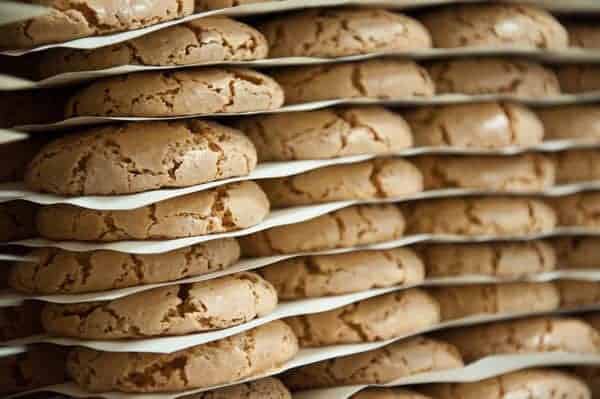
Until then, macaron was a simple almond biscuit, crunchy on the outside and soft inside. It was in the 1830s that they had the idea of assembling two macaron biscuits and filling them with jellies, spices or liqueurs, and then with different flavors of cream, ganaches or marmalades.
In the early 20th century, Ladurée of Paris created the colorful macaron in its present form with a wide variety of colors and flavors. From that moment the candy knows a new wave of success in the capital.
Macaron crosses the ocean
Continuing its route through the centuries, the macaron, considered one of the symbols of French confectionery, crosses the Atlantic to conquer America and gain an international dimension. In 1993, chef de pâtisserie François Payard offers this small biscuit to customers at the “Daniel” restaurant in New York. And of course, it’s a success!

How to make macarons?
You can come and join our macaron class in Paris! But if it is not possible, here is a step-by-step guide for you to do everything according to French art!
I – The base Ingredients
To make macaroni there are three basic ingredients: almond flour, icing sugar and egg white. In addition, a few grams of white sugar to assemble the whites, lemon juice and possibly food coloring, preferably natural. You can also use a spoonful of cocoa powder, according to the taste you wish to achieve. Yes, as you can see the list of ingredients is simple!
Keep in mind that almond flour and icing sugar should be mixed and sifted.
The whites should be weighed exactly and, above all, should be at room temperature. To do this, they should be removed from the refrigerator and stored for at least 12 hours at room temperature in a hermetic container.
II – Beat the whites into snow
At this step, beat the egg whites into very firm snow with a little lemon juice. Add the white sugar and add the color you want.
It is important to incorporate the sugar in two steps and do not throw everything at once. As a result, the whites should be firm and shiny.
III – Macaronage: a delicate step
After the previous step, when the egg whites are firm, gently add the almond flour and icing sugar, and with a spatula, gently mix to avoid breaking the egg whites. Make a slow, steady gesture toward the center of the bowl as you spin it one quarter at a time in a circular motion. At the end, the mixture should be shiny and when lifting the spoon we should see a ribbon.

IV – How to make a perfect macaron crust
Fill a bag of confectioners with the dough you just made and make small cups 2 to 5 cm wide in a baking dish lined with butter paper or silicone carpet. Be sure to space each of them well so that when baked do not stick together. You can then, at this point, decorate your macaroni by sprinkling nuts, chopped dried fruit, chocolate powder and whatever else your imagination wants.
Let the macarons rest for 1 hour. They will dry. And with that the macaron will create a “crust”.
V- How to cook the macaron
Preheat the oven to the specified temperature. Place the baking dish containing the macarons in the oven, bake a maximum of 2 baking sheets at a time.
Cooking varies between 10 and 15 minutes, depending on the oven. Watch closely! Macarons should never get brownish! If they brown it is a sign that they cooked too much. The cooking time varies and should be adjusted according to the ovens.
If you do not have a ventilated oven, cook with the door slightly open with a cloth or a wooden spoon.
When the macarons are cooked, remove them from the oven and allow to cool for a few minutes. Then pour some water between the parchment paper and the plate (not in the macarons, for God’s sake!). This will help to remove them without breaking. Wait one more minute before gently peeling the macarons from the parchment paper.
Another technique: Place the parchment paper on a slightly wet countertop and remove the macarons with the delicacy. Let them dry for several hours.
VI – Garnish them, assemble and … wait: there is still one last step before eating
In the crust stage when the macarons rest for 1h, you will have plenty of time to prepare the filling of your preference.
Take a macaron, with the help of a pastry bag or a small spoon, garnish it with the filling and cover it gently with a second macaron, by pressing them very slightly. Remember: macarons are fragile.
Keep your macarons in a cool, dry place or in the refrigerator.
And above all, wait until the next day to savor them! The macarons are part of that group of foods that get much better the next day. Once the filling (chocolate ganache, jelly, jam, caramel, cream or any other) has penetrated the macaron, it will be soft inside and crunchy on the outside.
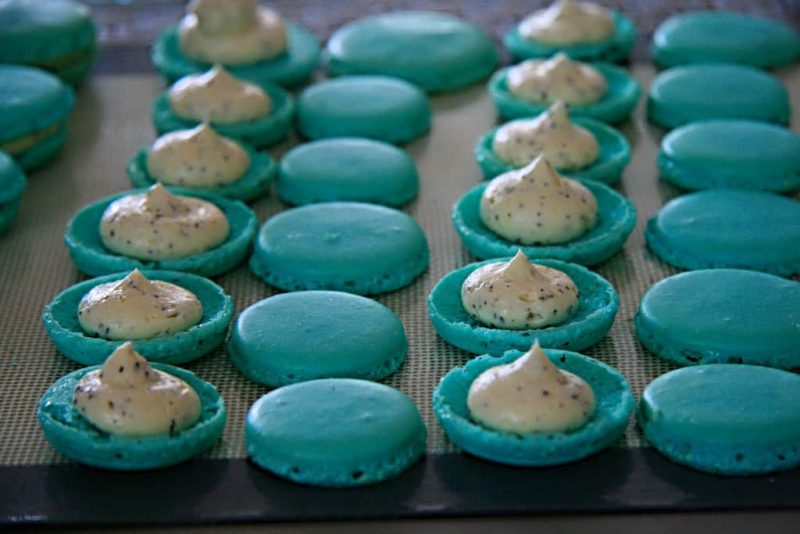
VII- The Expected Result
Basically, how should a successful macaron be?
Here are some essential criteria:
– the macaron should be perfectly round
– the macaron should be perfectly smooth
– the macaron must have a collar at its base
– the macaron should be brilliant
– the macaron should have a tone corresponding to its fragrance / ornament
– macaron should have a nice uniform color
– macarons must have the same diameter
– the collar should be neither more nor less broad than the top of the macaron
– the filling must be visible
– the filling must be a minimum of 3 mm thick
– the filling cannot be very liquid or fluid
VIII – How best to store my macarons?

You’ll absolutely need an airtight carton that will ensure that the macarons do not come in contact with excessive heat, moisture, and do not dry out or absorb external odors.
Macarons can be stored in a box in the refrigerator, say for about a week. Little reminder: beware of macarons stuffed with fillings that carry gelatin, they will be soggy.
The macarons also freeze very well! They can be stored for up to 6 months at -18 ° C. They thaw very easily, removing them for about 30 minutes at room temperature but once thawed they must be eaten and can no longer be frozen.
IX – Do not be discouraged! The key to success in making macaron
Did not your first attempt work? Do not be discouraged. Making macarons requires practice, time and patience. If you miss your first macarons, do not despair: start again, beat the egg whites in a firm snow, increase the crusting time, adjust the temperature and cooking time … Adjust, do not give up, and come and take a macaron course here in Paris with us. You will become a star!

Tips and tricks to make the best macaron in the world
– Separate the whites from the yolks for at least a few hours and leave it at room temperature
– Process the almond flour + icing sugar to become even thinner
– After processing sift well together
– For the coloring, integrate natural food coloring if possible and do it only at the end, whether liquid, paste or powder (note that the powder has a very strong coloration)
– At the moment of “macaronage” (mixing the almond flour with the egg whites), make subtle and wide gestures with the silicone spatula, start at the edges of the bowl and go to the center. The preparation should remain frothy and make noise during the macaronage. This will ensure that whites grow to perfection.
– When baking, you should see the collar at the base of the macarons, but this usually occurs after about 6 minutes of cooking, and remains until the end.
– Macarons should detach from the parchment paper without difficulty: when they leave the oven wait about 1 minute, then carefully remove, they should leave no traces on the paper. If they are not cooked enough, you will find some of the dough on the paper, in this case it would be necessary to continue cooking a few minutes or use the water technique I taught up there (in fact, the humidity will rise and soak the paper, the macarons will take off more easily) but be careful not to let the paper soak for a long time, so the macaron does not soften
Some possible problems that can occur when making macaron
Here is a non-exhaustive list of flaws already seen here or there and an attempt at possible explanations:
– Macarons have large grains on the surface; have a rather uneven appearance with bumps and / or buttons
This is because almond flour and icing sugar have not been sufficiently mixed or sieved, or that a homogenous mixture has not been made in the macaron. The great “warts” are due to the fact many times, of fearing to mix a lot of preparation and the clear ones to become liquid! So they stop this process too soon and the whites are not mixed properly. This is one of the common and flagrant problems in the aesthetics of a macaron.
– Macarons break
There is water somewhere: in the room where you let them rest for the crust before baking, in the oven, on the plates or, finally, in the dough. Or even, there was great heat shock with for example the baking sheets were very hot from a previous batch
– Macarons are not round
Bad behavior of the pastry bag, poor pressure pastry bag, poor movement during the realization of the circles in the baking dish, or even maybe many baking pans in the oven overlapping.
– Macarons does not have a collar
Its preparation was not frothy enough after macaronage or many baking pans in the oven overlapping.
– Macarons are flat
You probably make the macaronage step more energetically than necessary and “broke” the egg whites
– Macarons do not peel off parchment paper
Maybe you have taken it out of the oven too soon. Bake them for another minute or two might help. Or put place the parchment paper on a slightly wet surface..
– Macarons have folds, bumps, bubbles
Your oven is not hot enough, or crusting conditions should be checked (location, duration)
Macaron recipe (the best macaron in the world)
The recipe is the same one we used in our macaron course here in Paris . However in the macaron classes we give here we regularly change the fillings to create new and amazing flavors. The important thing at the time you are going to do is to read carefully the tips tricks taught above.
Macaron Recipe (for about 50 macarons with 3cm in diameter)
150g almond flour
150g of icing sugar
2 x 60g egg white
For the sugar syrup:
150g white sugar
40g of water
For the chocolate ganache
150 ml fresh cream
250g of chocolate
10g butter
Mix the almond flour and the icing sugar to obtain a fine and homogeneous powder. Sift the two for three times to get a very thin mixture and set aside.
In a pan, put the water, white sugar and food coloring powder to boil. The use of a thermometer is essential because the temperature should not exceed 121°C.
Put the first 60g of whites and beat them into snow in the bowl of the mixer, but do not leave too firm. Reduce the speed, pour the sugar syrup over the egg whites in a thin stream, let the mixer beat until the meringue is almost cold (count 10 good minutes).
Meanwhile, mix the remaining 60g of whites (not whipped) with the icing sugar and sifted almonds to get a thick, sticky almond paste.
First add a small amount of meringue to the almond paste. Then mix the meringue in three rounds. Do gently so as not to break the meringue too much.

Fill a pastry bag with this dough. On a baking sheet with parchment paper or silicone carpet make circles of 3 cm in diameter, separated, because the dough will spread!
Let the macarons rest for 1 hour to allow the crust to form.
Preheat the oven to 145°C for 10 minutes leaving a second plate in the oven. Very important step !!! Plate superimposition allows the macarons to inflate well and produce the famous ‘collar’. Bake for 15 minutes at 145°C. At the end, let it cool completely before gently removing the macarons.
If they are cooked enough, they will easily take off from the baking sheet, otherwise continue to bake.
Prepare the chocolate ganache: In a saucepan, bring the sour cream to a boil. When it boils, turn off the heat, add the chocolate cut into pieces in the cream, always stirring with a wooden spoon. Add the butter and mix until dissolved. Finish hitting the ganache with a wire whisk to obtain a creamy consistency. Let it cool completely (you can do the ganache the day before or hours before).
Wait for the macarons to cool. To stuff your macarons, combine half, placing a spoon of ganache on one side and close with the other half gently. Let the macarons rest a little fresh before serving them for at least 12 hours or even better, if you can wait until the next day.
The best macarons in Paris
I like to say that the best macarons in Paris are the ones I do here in our macaron class 🙂 But if you want to buy them ready or to take away as a gift, here is a guide to where to buy the best macarons in Paris. It is worth remembering that many of these boutiques (and other wonderful ones) we visit in our tour The French Patissery.
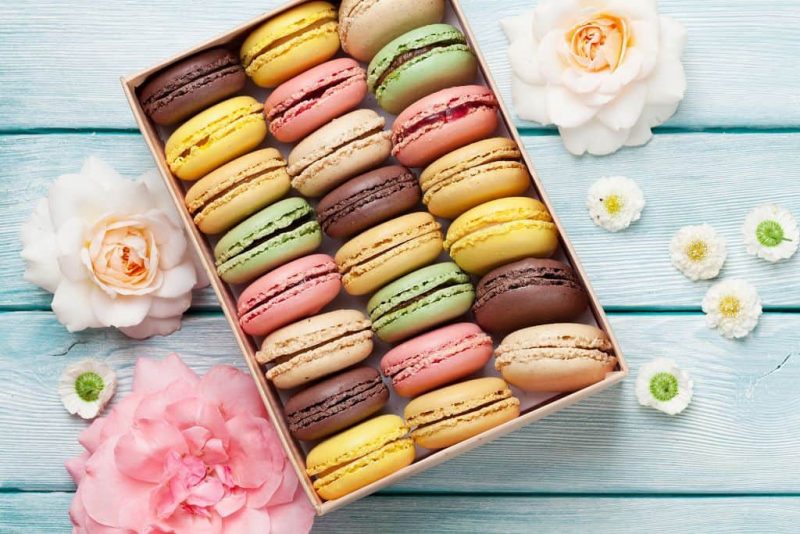
Where to buy the best macarons in Paris
Ladurée
As the creator of the modern macaron, Ladurée is the most famous macaron maker in the world, and that’s why, first of our list. It is worth visiting the Ladurée to experience a real institution of the French pâtisserie.
75 avenue des Champs-Elysées, 75008 (and other addresses)
+33 1 40 75 08 75
Open every day from 8:30 a.m. to 11:30 p.m.
https://www.laduree.fr/
Pierre Hermé
Pierre Hermé makes our favorite macaron in Paris. Always at the forefront of the flavors he is known for his bold combination of ingredients.
72 rue Bonaparte, 75006 (and other addresses)
+33 1 43 54 47 77
Open every day from 10am to 7pm
https://www.pierreherme.com/
Gérard Mulot
The most well-balanced macaron in Paris: a light, crispy biscuit with a perfectly meticulous filling.
76 rue de Seine, 75006 (and other addresses)
+33 1 43 26 85 77
Open every day, except Wednesday (closed) from 7 to 20 hours.
Aoki Sahdaharu
The Japanese roots of chef Sadaharu Aoki are clearly reflected in his macarons. It combines classic French flavors with the subtle and unique scents and textures of Japanese ingredients.
35 rue de Vaugirard, 75006 (and other addresses)
+33 1 45 44 48 90
Open from Tuesday to Saturday from 11am to 7pm, Sundays from 10am to 6pm, closed on Mondays
www.sadaharuaoki.com/boutique/paris-fr.html
Carette
Macarons with fruity and powerful fillings steal all the spotlight in this traditional French confectionery.
4 Place du Trocadero, 75016 (and other addresses)
+33 1 47 27 98 85
Open from 7am to 11.30am during the week, and from 7:30 AM to 11:30 PM on weekends
www.carette-paris.fr/
Dalloyau
Dalloyau claims to be one of the first manufacturers of modern macaron. Following its 300-year-old recipe, its macarons are the most primitive, yet retaining the crunchy, chewy meringue texture that is now uncommon.
63 rue de Grenelle, 75007 (and other addresses)
+33 1 45 49 95 30
Open daily from 9 a.m. to 8.30 p.m.
www.dalloyau.fr/
Pouchkine Café
Pouchkine coffee is known for its grandiose items inspired by Russian royalty, and its macarons also make a bold statement. Brilliant colors and extravagant interior.
155 Boulevard Saint Germain, 75006 (and other address)
+33 9 67 28 58 44
Open daily from 9:30 am to 8:00 pm, except for closing on Sundays
www.cafe-pouchkine.fr/
Fauchon
A little more crispy than average, the macarons themselves are, like the rest of the store’s products, delicious and reliable.
24-26 Place de la Madeleine, 75008
+33 1 70 39 38 00
Open from Monday to Saturday from 9am to 8pm. Closed on Sundays
https://www.fauchon.com/
